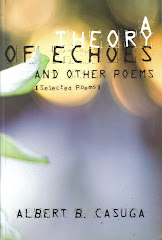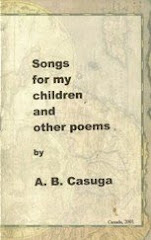
(Sa atin din may Wasteland)
FOR ALL THE OLD FRIENDS
(For Cesar Leyco Aguila in Australia and Isagani R. Cruz who advocates this type of multilingual writing.)
--- I grow old…I grow old…
I shall wear the bottoms of my trousers rolled.
---T .S. Eliot, The Love song of J. Alfred Prufrock
1.
It’s garbage day today; it’s time to discard the refuse.
An inspiring mantra, I mutter, before I slip into autumn galoshes
Looking brightly at a voyeur’s walk through neighbourhood muck
Arranged immaculately into green, blue, grey, and sepia bins
Mandated to guarantee that the week’s basura and mierda ---
Prophylactics and sanitary napkins, masticated fries vomited
With the arrant fish bones, newsprint-wrapped pet faeces,
Faded pictures of grandmere leering at grandpere glancing
At some tightly dungareed wench flaunting palpable haunches
Sans underpants that was last millennium’s acceptance of taste
If not coyness or even breeding in vaulted manors of delicadeza ---
Are picked up by the City Dump Meister on an antiseptic mission
To rid these fallen-leaves-strewn paseos of accidental memories,
Recuerdos de faltas pasadas, putrid waste of body functions
And memento mori gone past their memorial usefulness.
2.
These streets are the starkest salons of the rejected.
But I, an essential old man of windy spaces, I build caminos
Of broken dreams, the day’s fleeting temple of crumpled portraits
(A lass on a pony, a go-soon clamping down on a pell-mell skirt
Blowing up with the wind come to frolic with limbs on a swing
Of wings, (Aieeee….que bueno! Que linda! Siempre fuiste la razon
De mi existir! Las lindisimas mujeres! Sangre del amor! ), a campesino
With the ugliest-looking bass this side of the Credit River dangling
From the rod of ages, old women in antediluvian bloomers
Cavorting with Holocaust-surviving skeletons picking grapes
From a refuge of Neapolitan vineyards. Forgotten portraits,
Forgiven hurts, nurtured loves, haunting desires:
C’est mon vocu le plus cher.)
3.
On garbage days, I walk the boulevards of refuse absented from
Their satiated origins, pick up discarded whistles or some such
Aeolian reeds, pick up reusable stuff better known as un tesoro
Hallado de basura de otro hombre – televisions, computers, ipods,
Stereos, stoves, microwave ovens gone kaput or obsolescent,
Bathroom douches, screws, nails, tacks, pens, mock penile-shaped
Doorstoppers, and music boxes still wound to play Volver a Sorento.
The dumpster looking majestically impregnable upon its pedestal
At the Senior’s Home is spray-painted with blood-red letters “J.C.” ---
A startling graffiti proclaiming “SAVES” (a jumble of garbage chutes
Astride the metal bin) makes one cogitate: JC SAVES. Jesus Christ
Saves. The Catcher in the Rye, indeed. El hombre propongo,
Y Dios Dispongo. What man has built on his crumbling sandboxes
Only God can make last, like the Temple J.C. built upon some Rock
“Where the Gates of Hades shall not prevail against it.”
4.
I, an old man, accept the wisdom of the dumpster: How much
Garbage, indeed, has Jesus as dumpster caught that they may
Be delivered to the proper dumpsites of vile, filth, and dirt
So that they may, as human dregs, be recomposed as food
For the worms, the essential worms? On a morning constitutional,
A cathedral is no better than the dumpster where J.C. saves
The refuse of a lost paradise as compost for a paradise regained.
I am in good company as a picker. The Good Fisherman picked
His minions from the dissolute fisherfolk and bade them fish
Where fish was not. The Great Mao gathered his rebels as firesticks
On Hunan and burnt the hills to bear the fruit for the wakened Tiger.
Did not Mahatma Gandhi-ji gather his poor to cram the railways
That rendered them supine and in penury, that they may rise
And subdue the Empire that once did not see a sunset? Shantih.
Shantih.
5.
Onto my dying days, I, an old man on the streets of dung,
Shall recall to any lad or lass who would listen: Ang Kagalangalangan,
Kataastaasang Katipunan ng mga Anak ng Bayan ay siyang gumulpe
Sa mga Kastilang nagbenta sa Amerika ang Inang Bayang Pilipinas,
At tumuli sa mga dayuhang Yanqui upang ang PIlipinas ay lumayang muli.
At ang mga Bolomen? Hindi nga ba sila ang mga gerilyang pumutakte sa
Mga sakang ng Bayang Hapon nang ang Pilipinas ay muling nagwagi
Maski na hindi nakabalik on opportune time si Heneral Douglas McArthur
Upang kanyang tuparin ang kanyang pangako: I shall return?
Sila man din, itong mga kababayan ay lahat mistulang dukha, pulut sa basura
Ng tadhana, namayani, ang tuloy na ring sumugpo sa karimlan maging ito’y
Digmaan or dili kaya’y baha, martial law, GMA, at iba pa. Sa Manila ngayon,
Basura sa baba, basura sa gitna, at basura para rin sa kataastaasan. (1)
6.
Its garbage day on Tuesdays here, Hermano, and that’s when I go picking
Refuse, myself included. I pick my decrepit body up from its hapless
Detritus, and whistle for the wind. We cannot be old men here,
Where when we reach the end of our walk, a little boy or girl awaits
With outstretched hands, running on the wings of love and glee, to give
Their grand abrazo, besito y abuelo, abuelo! The old man is back.
He did not perish along the way. So should you not, Hermano.
We need to walk through more garbage days. Because I have not seen
Any discarded book along the way, I promise you garbage days
Are good while the Word is not yet muck with the filth of waste.
Do you have garbage days in Wales? Sydney? The Outback?
In garbage days we trust.
Missisauga, Canada, October 27, 2009
__________________
(1)English translation:
Onto my dying days, I, an old man on the streets of dung,
Shall recall to any lad or lass who would listen:
The Honourable and Supreme Organization of the Country’s
Children (KKK) destroyed the Spanish colonial master
Who sold the Philippines to America and also cut the Yankee
Balls asunder so that the Philippines would again reign free.
And the Bolo Men? Did not its freedom fighters wreak havoc
On Japan’s bow-legged troops to win yet another war despite
The tardy return of General Douglas MacArthur who pledged:
I shall return? They, too, these impoverished compatriots,
Veritable recruits from the dumpster bins of Colonial Fate
And fortune, have overcome the grim disasters be they wars,
Floods, martial law, GMA (Gloria Macapagal Arroyo), etcetera.
In Manila this time around, there’s garbage below, garbage
In the center, and garbage, too, above.




























